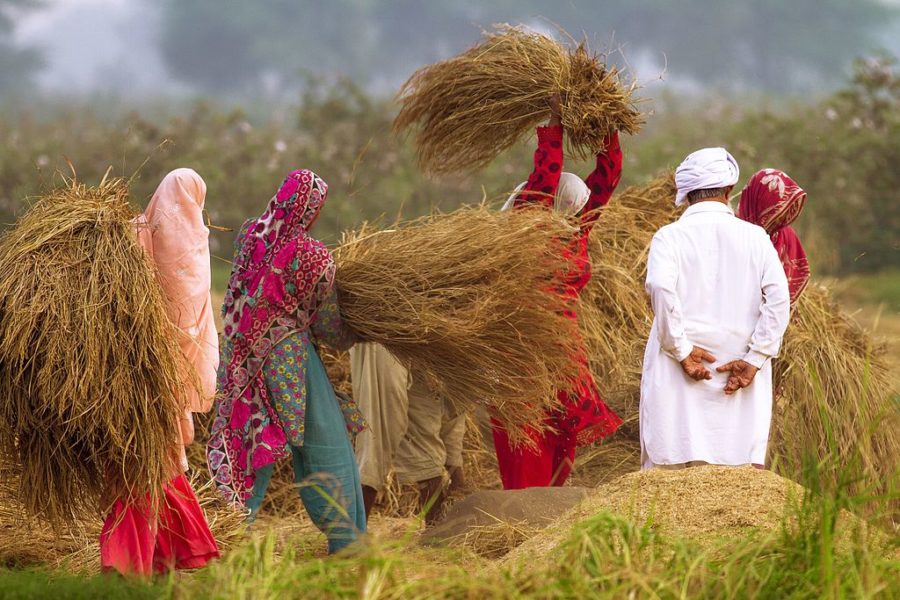Mr. Bilal is an agronomist student at the University of Agriculture, Faisalabad. He has been writing blogs on national and international politics and international relations since 2017.
The Agricultural Sector of Pakistan
Pakistan possesses one of the most diverse climatic zones, from extremely hot summers in the east (Punjab) to the freezing colds in the north (Khyber Pakhtunkhwa and Gilgit). Its land topographies stretch from the scorching desert of Tharparkar to the snow-laden glaciers of Baltoro and Biafo, along with the Karakoram range, with the vast alluvial plains of Punjab and Sindh extending between them. Despite having all the types of weather known to humanity and every variety of soil found suitable for plants, the agricultural sector in Pakistan still manifests several critical but fundamental issues which are holding back its true ability to drive the national economy.
The Pakistan Economic Survey of 2020-21 reported 2.77% growth in the agricultural sector against the target of 2.8%. It also stated a 22% increase in sugarcane production and a 13.6% boost in rice production while the food crops of wheat and maize witnessed 7.4% and 8.1% growth, respectively. All of this sounds well and good but something is missing.

While the biggest growth is shared by sugarcane which only contributes roughly 0.7% to the national GDP, the crop that accounts for 10% of the GDP and 55% of the foreign reserves, cotton, suffered a decline of 22.8 percent in production. The cotton yield fell from 9.148 million bales to 7.064 million bales since last year. The reduced production percentage was almost equal to the growth observed in sugarcane production. Considerable portions of foreign reserves have been spent on importing the key commodities of sugar, pulses, cotton, and vegetable oils.
Seed Sector
Seeds play the most pivotal role in a country’s agricultural production but in Pakistan, it might also be the most neglected one. Following Independence, there was no major enactment or public/private sector establishment of any kind of seed corporation till 1976.
Ayub Agricultural Research Institute—founded in 1961 by the detachment of Punjab Agricultural College & Research Institute Lyallpur (1906)—and West Pakistan Agricultural Development Corporation(WPADC) installed in the same year, failed to create any substantial difference regarding the seed sector.
Despite the ratification of the first seed law of Pakistan, West Pakistan Seed and Fruit Plants Ordinance (1965), there was still no legal framework for seed testing and certification and along with that, the inefficient marketing led to WPADC being dissolved in 1972. The 1976 Seed Act, brought up by the legal and later financial assistance of the World Bank, paved the way for the establishment of the National Seed Council (NSC) and Federal Seed Certification Agency—both of which were merged in 1997 to form the Federal Seed Certification and Research Department (FSC&RD).
There are currently 786 small and medium national seed companies, and four multinational companies, along with the public sector seed corporations, operating in Pakistan. Although the 1976 Seed Act proved significant in introducing the necessary legal framework and infrastructure for the birth of the seed industry in Pakistan, the ground realities still have not experienced the dramatic shift towards the production and usage of high-yielding varieties.
The 2015 Seed Amendment and the 2016 Plant Breeders’ Rights Act were intended to open the industry to the private sector, allowing them to set testing laboratories and provide exclusive rights protection to breeders for their developed varieties. However, it ended up ensuing a debate familiar to almost all developing or even some developed countries in the world.
Critics argued that these legal reforms will enable international corporations to monopolize the agricultural sector in Pakistan. Farmers can be legally obliged to buy seeds from licensed companies at every cropping season and can be fined or imprisoned for otherwise storing and sowing their seeds. 82% of the certified seeds are being sourced from the private sector, that too from the few dozen companies at the top.
Hundreds of seed firms lack the necessary infrastructure and funding required to research and develop new varieties. The government needs to enhance its capacity for seed production while also empowering small companies and establishing practical regulatory mechanisms.
A lot of ink has been devoted to discussing the negative implications of seed monopoly and genetically modified (GM) crops. More than half of continental Europe has already moved to ban these GM crops owing to their potentially damaging effects on biodiversity and human and environmental health. Yet, despite their adverse effects, there are also countless benefits attached to the adoption of GM crops; they require far lesser pesticide and herbicide usage and emit a reduced amount of greenhouse gases due to lower fuel applications.
The government of Pakistan needs to develop comprehensive policy guidelines including land reforms, to cap this well once and for all. If the concerns raised by the environmentalists and indigenous farmers with small landholdings are legitimate, then the legislature is better to formulate a middle ground to regulate it aptly because history tells that an utter ban on technology has never been effective in achieving anything.
Irrigation System
One of the largest Irrigation systems in the world, encompassing multiple major reservoirs, barrages, canals, and streams, is now obsolete and inefficient. Seepage losses in lined and unlined canals are ramped up to 45.5% and 66%, respectively. With no large dam constructed in the last forty years, the country has continued the tradition of wasting millions of acre-feet of water to the sea.
The economic value of one million acre-feet (MAF) of water is estimated at a billion USD and last year alone, 29 billion dollars worth of water went down unutilized through the Kotri Barrage into the Arabian Sea and all of this is happening with an impending water crisis in the near future.
The per capita water availability in Pakistan has fallen to 1,038 cubic meters, which is rather close to the water scarcity level of 1,000 cubic meters. Waterlogging, salinity, the reduced storage capacity of the reservoirs, failure of the delivery system to reach the lands at the tail end, and the farmers’ inability to go for advanced irrigation practices, like sprinklers and drip irrigation, due to financial constraints are also the factors anchoring the agricultural sector in Pakistan.
Fortunately, the current government has taken the issue of agriculture and climate change quite seriously and adopted measures to boost the agricultural sector in Pakistan. Immediate construction of ten major dams and hydropower projects across the country has been initiated. The Diamer-Bhasha and Mohmand Dams alone will add an estimated 9.3 million acre-feet to the national water storage capacity, irrigating millions of acres along the way.
Apart from dams, the Government of Punjab has also enlisted several irrigation projects in the provincial budget (2021-22), which are of paramount significance due to their impact. These include the Disaster and Climate Resilience Project (worth 10.7 billion), the Trimmu Barrage, and Panjnad Headworks (worth 16.8 billion).
Nevertheless, the most remarkable project is the Jalalpur Canal, which is almost a 50 billion rupees project, originally envisioned in 1898 during British rule, The 116 km length canal will be the future source of irrigation for the 170,000 acres of Jhelum and Khushab; it’s the only major canal project in the last 55-years, after the Taunsa Barrage.
While these projects will contribute a lot to resolving the problems in the irrigation system, issues in already existing irrigation infrastructure and problems at the lower levels (tehsil and village) are still unaddressed and demand expeditious attention from the government.
Plant Protection Aspect
One of the several causes behind the sharp decline in the cotton yield is insect attacks and insufficient plant protection measures against weeds. According to an estimate, insect infestations are responsible for the 20-40% annual yield and quality losses in Pakistan’s cotton production.
The farming community often can not afford the pesticide sprays and even if they do, their endeavors prove fruitless due to a couple of reasons. Sometimes they lack access to consultations from agricultural experts and they tend to pick the formulations on the basis of common usage in their neighborhood and often spray them without proper training. These practices can render pests and weeds resistant apart from being no help in protecting the crops.
There are also complaints reported from numerous areas in Punjab of adulterations in the pesticides products to increase the volume which leaves these sprays ineffective. Although the agricultural department actively conducts raids against these “fake pesticides”, dumping hundreds of tonnes of adulterated pesticides to police stations, the open-air exposure of these chemicals is causing health concerns.
Due to this reason, the agricultural department has recently proposed an action plan for the environment-friendly disposal of these pesticides. Although the research institutes and seed corporations have developed certified insect-resistant seed varieties, especially in cotton, their high prices and the overall extensive care required by the cotton crop is why farmers are moving towards crops with lesser risk like sugarcane and rice.
Post-harvest Losses
35-40 percent of the fruits and vegetables produced in Pakistan end up in post-harvest losses which according to the Asian Development Bank stands at a little more than $1 billion, annually. Substandard or no storage facilities, and inadequate care during handling and transport of perishable agricultural produce contribute to these heavy losses.
Pakistan’s agri-processing and food value addition industries are either non-existent or growing at a pace that renders them insignificant in highly competitive international markets. Due to this, the state’s fruit and vegetable products suffer from far lower pricing than the other fast-emerging but still smaller economies like Kenya. The Government of Punjab has taken initiatives to establish cold storage facilities under Punjab Agricultural Marketing and Regulatory Authority but these efforts still haven’t translated into results.
Livestock Sector
Technically, the livestock industry also comes under agriculture and some of you would be surprised to know that 60% of the GDP of the agricultural sector of Pakistan comes from livestock and not agronomical farming (crops and fruits). According to Pakistan’s Economic Survey of 2020-21, the livestock sector overall accounts for an 11.5% share of the national GDP and secured growth of 3.06 %, and employs 30 million people, mostly from rural areas.
The most vital commodity of the livestock industry is milk. Pakistan stands as the fourth biggest producer of milk in the world—after the United States, India, and China—with an annual production of 63 million tonnes from 2020-21. As per the Pakistan Dairy Association, Pakistan can achieve around $30 billion in exports by only facilitating and enhancing the production of milk and other dairy products. Currently, whole livestock products make only up to 3% of the total exports.
Following milk, the next biggest livestock product is halal meat, in which Pakistan should be at the top of the list of world exporters, but it ranks 18th with only a 3% share in global halal meat exports. Surprisingly, there isn’t a single Muslim majority country in the top 5 leading halal meat exporters to the states of the Organization of Islamic Cooperation (OIC). The list is topped by Brazil, the United States, India, Russia, and Argentina. Livestock experts state the industrial capacity of Pakistan’s halal meat exports at 50 billion PKR.
The key issues of the meat sector include the lack of modern processing units and an absence of cold supply chain management systems to live up to the increasing demand for quality meat. The excessive use of antibiotics in food animals, which increases the risk of the occurrence of drug-resistant pathogens, is also a major problem.
Last year, six Pakistani companies registered in the Kingdom of Saudi Arabia for halal meat exports while in April this year, Pakistan received China’s approval for meat exports after the establishment of a heat treatment facility for virus removal. China is the biggest meat importer in the world and it will surely assist a lot economically and in general industry improvements.
The leather industry in Pakistan is reportedly the second-largest exporter after textile. It suffered a considerable blow last year at the hands of a global pandemic, high costs, and a dynamically competitive international market. Biogas is another renewable but undervalued energy source that has the capacity of producing 12-16 million m3/day of biogas.
Besides the need for government initiatives in quality and quantity improvements, Pakistan also lacks proper research and development (R&D) in the livestock sector to formulate and introduce effective technologies and measures. The country only spends 0.1% of its GDP on R&D while the global average stands at 3% and it may be even higher for developed countries.
Precision Agriculture
These were only the fundamentals of tuning an already present agricultural economy, but the developed countries, like in all other scientific fields, are way ahead of Pakistan in advanced farming practices. The world is entering into the fourth agricultural revolution with hyper-optimized precision agriculture techniques for better & sustainable resource use, profitability, and quality. Whereas, a major portion of Pakistan’s farmers hasn’t been able to even move toward mechanized farming.
Precision agriculture is a farming concept that involves everything from satellites imagery, GPS, tractors mounted sensors, and remote sensing (sensors placed in soils) to drones for collecting data, putting it through statistical analysis and mapping it, and then optimizing the practices aimed at the highest yields without the least resource wastage and environmental damage. There are few examples of the application of this concept in the private dairy farming sector but the broad adoption hasn’t been noticed in crop and horticulture businesses, not even on large farms.
The Agricultural Sector of Pakistan and the Potential of High-value Crops
“This year we are going to approve a project where we are growing tea on an area of 25,000 acres; we are creating history; we plan to complete the proposed tea plantations over the next five years,” remarked Jamshed Iqbal Cheema, the special assistant to the prime minister on agriculture and food security, on his visit to National Tea and High-Value Crops Research Institute (NTHRI) at Shinkiari, Mansehra.
Pakistan is the top tea importer in the world and annually spends 90 billion PKR on purchasing tea from 15 different countries, putting critical stress on its foreign reserves. Jamshed Iqbal Cheema stated that Pakistan has 178,000 acres of tea cultivable land and “Pakistan can grow its own tea”.
In 2019, the Food and Agriculture Organization (FAO) of the United Nations published Agro-Ecological Zones of Punjab, after a two-year-long collective and meticulous research cooperation between three major agricultural universities—the University of Agriculture, Pir Mehr Ali Shah Arid Agriculture University, and Muhammad Nawaz Shareef University of Agriculture—dozens of research institutes and government departments, and FAO Pakistan.
The effort was aimed at identifying the most suitable and beneficial cropping systems and providing necessary information to everyone from the policymakers, businesses, multinational corporations, research institutes, and farmers to optimize their agricultural choices and practices according to their specific regions. It was the first effort of its kind in nearly four decades; it was aptly called for as Pakistan’s majority farmers never even wondered to move towards site-specific cropping decisions and products having high value and big net returns.
Government-led projects to promote olives farming in Pakistan have been happening since its introduction in 1968 but efforts gained significant momentum in recent years. Pakistan Agriculture Research Council (PARC) pioneered the pilot project of a large-scale olive plantation worth 3.82 billion rupees with the Italian government in 2012.
The Government of Punjab, through Barani Agriculture Research Institute (BARI), initiated a five-year plan in 2015 to declare and revolutionize the Pothohar region into “Olive Valley” by planting two million olive saplings in six districts, on an area of more than 15,000 acres, to foster local olive production, create sustainable income opportunities and reduce the import bill of edible oil.
Although the project was technically a failure, this failure was attributed to a shortage of funds, and the potential of boosting olive cultivation is still there. The federal government has now kicked off another five-year ambitious campaign to develop olive orchards in Khyber Pakhtunkhwa. The campaign aims to plant 4 million saplings on 30,000 acres along with the installation of nine olive extraction plants.
In addition to tea and olive, possibilities of high-value cropping in Pakistan are endless like the potential of growing beetle leaf and muskmelon in coastal areas of Thatta, safflower in Sindh and Baluchistan, oil palm in Sindh, and even one of the most expensive spices in the world, saffron—often termed as “red gold”—can be grown in Pakistan.
If we can steer our farming community in the right direction and remove the financial and technical challenges in its way, we can capitalize on the resources these lands are bestowed with, turning Pakistan into the agricultural and economical hub it’s destined to be.
If you want to submit your articles and/or research papers, please check the Submissions page.
The views and opinions expressed in this article/paper are the author’s own and do not necessarily reflect the editorial position of Paradigm Shift.



















